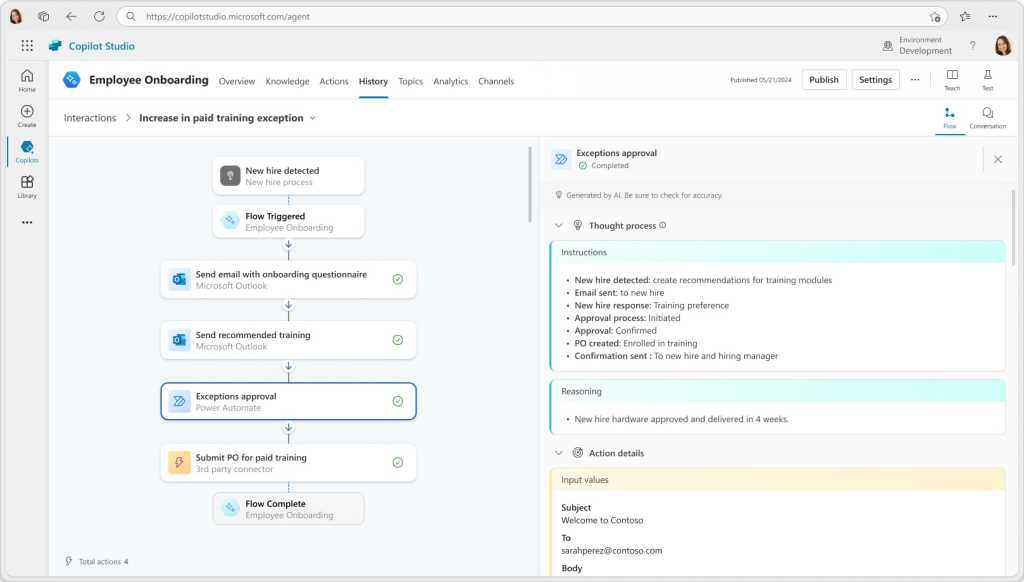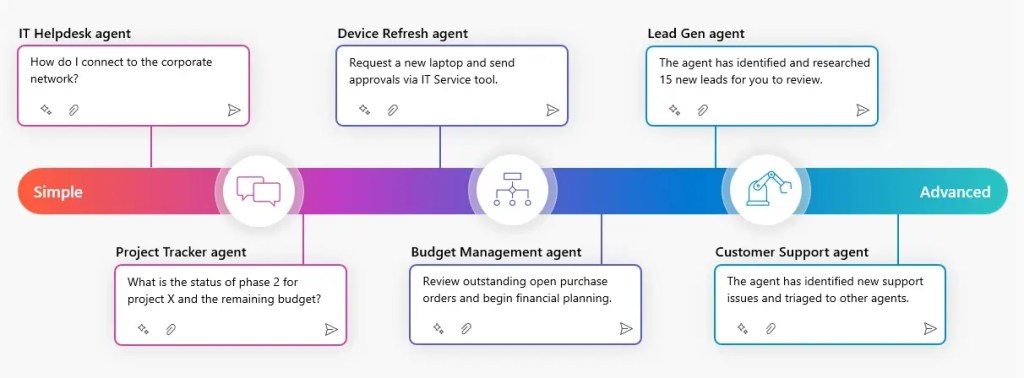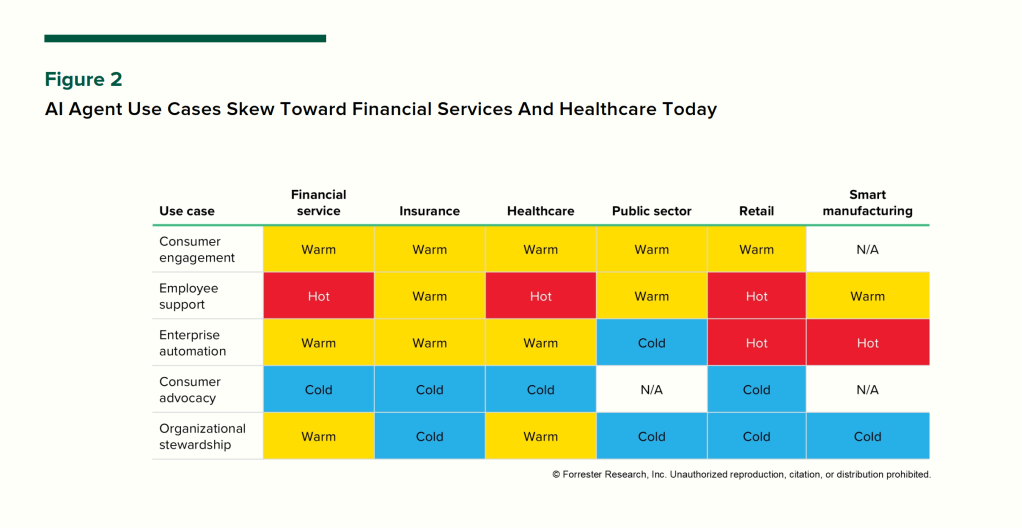
AI agents will soon be everywhere, automating complex business processes and taking care of mundane tasks for workers — at least that’s the claim of various software vendors that are quickly adding intelligent bots to a wide range of work apps.
Many companies appear to be listening. Over the next three years, at least 40% of Global 2000 businesses will use AI agents and agentic workflows to automate knowledge work, according to an IDC report, doubling productivity in the process — where the technology is successfully implemented, at least.
Should the technology live up to expectations, businesses will be faced with a significant shift in how work is done in their organization.
“People are not just being asked to adopt a new technology, they’re being asked to change the way they do their jobs,” said Amy Loomis, research vice president, Future of Work at IDC, “I think that the vendors don’t quite appreciate how much AI is altering who does what and how.”
What are AI agents?
At a basic level, AI agents can be viewed as the next stage in the evolution of the AI tools that are already embedded in many workplace software applications — the assistants or copilots that generate content or retrieve information as directed by a worker, such as summarizing documents and drafting emails, for instance.
Autonomous AI agents, on the other hand, can complete complex, multi-step tasks with little or no input from human workers, combining large language models (LLMs) with workflow automation triggers and actions. The goal is to create intelligent and highly capable assistants that can plan, reason, and execute work tasks independently, or with minimal human oversight.

AI assistants, advisors, and agents have different capabilities and use cases, according to IDC.
IDC
“For so long we’ve talked about the work about the work — the busy work, the stuff that gets in the way of you actually doing work,” said Chris Marsh, research director, Workforce Productivity & Collaboration at S&P Global Market Intelligence. “And I think there is a genuine opportunity now to really expedite high-value work by having agents automate all that crud.”
Defining exactly what an agent is can be tricky, however: LLM-based agents are an emerging technology, and there’s a level of variance in the sophistication of tools labelled as “agents,” as well as how related terms are applied by vendors and media.
And as with the first wave of generative AI (genAI) tools, there are question marks around how businesses will use the technology. IDC analysts pointed to business scepticism around AI agent performance, alongside privacy concerns, a lack of clarity around pricing, and a skills gap in terms of understanding how knowledge work is performed “outside of traditional-documented business processes.”
Nevertheless, Deloitte predicts that a quarter of companies that use gen AI will launch “agentic AI” pilots or proofs on concept in 2025, growing to half by 2027. “Some agentic AI applications, in some industries, and for some use cases, could see actual adoption into existing workflows in 2025, especially by the back half of the year,” said Deloitte staff in a report published this week.
Achieving the “substantial gains” promised by agentic AI will require “significant overhead in terms of teams and companies adjusting to what this world looks like,” said Marsh. “And there are bigger questions … do you have the right data architecture? Do you have the right integration strategy to actually make the next phase of agentic AI a reality?”
The agents are coming
The range of options for building and managing AI agents has quickly grown in the past year.
Numerous dedicated frameworks and development platforms for building AI agents —from both startups and established technology companies — are already available. Robotic process automation software vendors have touted agents as the next generation of intelligent automation tools.
More recently, enterprise software vendors have added no-code platforms into their apps, too.
Salesforce’s Agentforce was the centerpiece of its recent Dreamforce event with the launch of its Agent Builder, a low-code tool for building AI agents, while Microsoft made its “autonomous agent” builder within Copilot Studio available in a public preview this week.
This is likely just the start: Gartner predicts that a third of enterprise applications will include “agentic AI” by 2028, up from less than 1% in 2024, with 15% of day-to-day work decisions made autonomously as a result.
Agents are also coming to digital work apps that a wide variety of office workers interact with on a regular basis. Asana, Atlassian, Box, and Slack have been among the first to announce such features in recent months. “In some ways, it’s going to be just baked into the productivity apps that you’re using, like [Microsoft 365] Copilot,” said IDC’s Loomis.

An employee onboarding agent created in Microsoft Copilot Studio.
Microsoft
Then there are agents in development from the likes of Anthropic and OpenAI: these promise to actually take over a user’s computer and perform tasks on their behalf across multiple apps.
With so many tools in development or coming to the market, there’s a certain amount of confusion among businesses that are struggling to keep pace.
“The vendors are announcing all of these different agents, and you can imagine what it’s like for the buyers: instead of ‘The Russians are coming, the Russians are coming,’ it’s ‘the agents are coming, the agents are coming,’” said Loomis. “They’re being bombarded by all of these new offerings, all of this new terminology, and all of these promises of productivity.”
Software vendors also offer varying interpretations of the term “agent” at this stage, and tools coming to market exhibit a broad spectrum of complexity and autonomy.
At a launch event last month, Microsoft gave an example of a client onboarding agent built by consultancy McKinsey. The agentic workflow kicks into action when a customer email arrives — from here the agent extracts the relevant details from emails and follows a series of steps: checking for previous interactions, summarizing client needs, and identifying the correct McKinsey employee to meet with the client. Then it can write and send an email to the employee with the relevant client details.
McKinsey claimed that the agent was able to reduce its lead time by 90% and admin work by 30%.
Microsoft has also developed other agents with more limited capability. For example, a pre-built Employee Self-Service agent available in Microsoft 365 Copilot can take some actions on behalf of a user — such as updating HR profiles — but functions mostly as an AI assistant that provides responses to user queries based on its access to documents and data from apps such as Workday and ServiceNow.
Similarly, SharePoint agents basically function as customized AI assistants that help workers retrieve information from select files. And although Microsoft says that its Facilitator note-taking agent in Teams — one of several agents announced for Microsoft 365 apps at the company’s Ignite conference this week — will eventually manage meetings “end-to-end,” the initial incarnation doesn’t sound like a huge departure from what the Copilot AI assistant can already do in the collaboration app.
These may all be useful features, of course, but are examples of the different ways agents are being marketed.
Another workplace transformation looms
Many of the agent builder tools coming to business and work apps require little or no expertise. This accessibility means a wide range of workers could manage and coordinate their own agents.
Some software vendors claim that all knowledge workers will build agents to help them in their job.
“We think everyone will need to be able to create agents in the future, much like how everyone can create spreadsheets or presentations in Microsoft 365,” said Bryan Goode, corporate vice president for Business Applications at Microsoft, in an email comment to Computerworld last month. Alongside its Copilot Studio app, Microsoft has added a “lightweight” agent builder to its Microsoft 365 Copilot assistant, which aims to encourage a wide range of workers to create agents using natural language prompts from the AI assistant’s BizChat interface.
A recent IDC report predicts a “transformative shift in how knowledge workers approach their daily and project-oriented tasks and workflows” in the coming years, thanks to the introduction of AI agents that will perform tasks “both autonomously and interactively.”
“As frustration with inefficient processes and lack of technological support mounts, workers will quickly realize they can harness the new capabilities of LLMs to automate and augment portions of their jobs,” the authors wrote.
The IDC analysts forecast that a fifth of knowledge workers with no development experience will build their own agentic workflows by the end of next year. “Despite lacking formal development experience, [knowledge workers] will harness the power of LLMs conversationally to create personalized, agentic workflows,” analysts said in the report. This means describing “tasks, processes, problems, and goals” in plain language that language models turn into the code, scripts, or automation routines required to run personal AI agents.
Although he sees potential for all manner of workers to create agents for individual productivity, S&P’s Marsh said that, for the most part, it’s likely to be a smaller subset of workers that build agents to automate key business processes. “So if it’s a bunch of workflow automation in a sales team, it’s probably going to be the sales ops person who does that, or the marketing ops person in a marketing function,” he said.

AI agents will handle a range of business processes, from relatively simple to complex.
Microsoft
The introduction of agents will require businesses and workers to adapt to yet another substantial change to how knowledge work is carried out. The shift to a hybrid-remote model is barely complete for a lot of organizations, and the initial wave of generative AI assistants are only in the early stages of adoption at most businesses. Injecting AI agents into business processes will further disrupt how work is done.
“In the longer term … I actually believe that we will start to change workflows in businesses, from human-led to AI-led,” said Matthew Kropp, managing director and senior partner at Boston Consulting Group.
The deployment of new automation technologies inevitably raises the prospect of job losses too. But despite the potential for agents to automate work processes, IDC’s Loomis expects that the technology will reshape rather than replace jobs.
“It doesn’t mean your job’s going away,” she said. “It means you focus on different things, and your job is to manage or develop the automation. So people are going to have to get much more technically astute, to a certain degree.”
Craig Le Clair, vice president and principal analyst at Forrester Research, predicts that the net number of jobs will remain the same or grow, but increasingly advanced automation will eventually result in a significant shift in the types of roles that are needed.
“Agents will mostly affect the digital elite, which is the professional category, and the ‘middle workers’ for those lower-level cognitive tasks that they do in the mid-office, in the back office. Those are going to create the greatest shifts,” said Le Clair, author of the book Random Acts of Automation.

Use cases in industries with high interest in AI agents, according to Forrester Research.
Forrester Research, Inc.
“AI is going to not so much eliminate jobs — I think we figured out that we can’t really predict that anyway — it’s more having middle workers either move to front line, or in a positive way, have middle workers who become AI operators be able to move up … the ‘digital elite’ will be challenged with the diminished importance of their professional credentials,” he said.
Are AI agents ready to deploy?
While automation holds great potential to transform how work is carried out in future, the near-term reality for businesses is a different story.
The first generation of generative AI assistants and copilots have now descended into what Gartner terms the “trough of disillusionment,” with many projects remaining at a pilot stage due to a combination of factors: change management, a lack of clarity on ROI, and various security considerations, for example. And then there’s the propensity for language models to “hallucinate” answers. Many of the same challenges will be faced when deploying AI agents.
Businesses are understandably cautious about letting LLM-based agents act autonomously and access business systems, for example, even if they are subject to limitations in terms of the actions they are programmed to carry.
For the time being, most businesses will want some sort of human oversight. “There are no circumstances, at least right now, in which you would deploy this without some ‘human in the loop,’” said Kropp. This means that human workers have visibility into the agent’s actions and are consulted before taking riskier actions. That said, Kropp is confident that the problem of AI hallucinations will fade in significance as the technology matures, with agent reasoning capabilities also improving quickly.
While there are likely to be plenty of challenges along the way, Marsh expects that the combination of AI and automation will ultimately have a “profound” impact on how works gets done — even more so than other recent workplace shifts prompted by new technologies.
“I think the productivity gains are there. I think they’re real … If I think of all those changes that have happened over the past five years, this will be easily the biggest,” he said.
